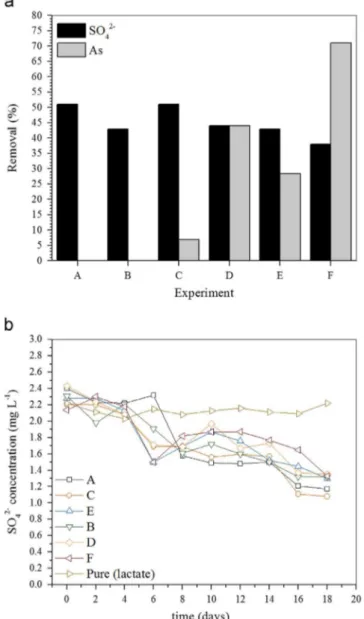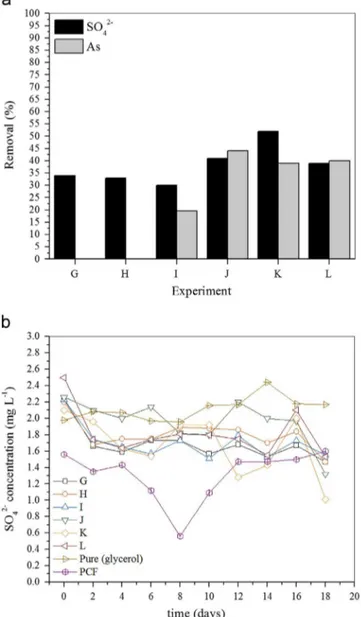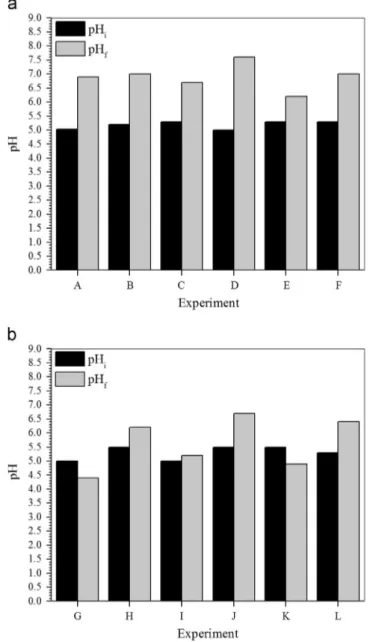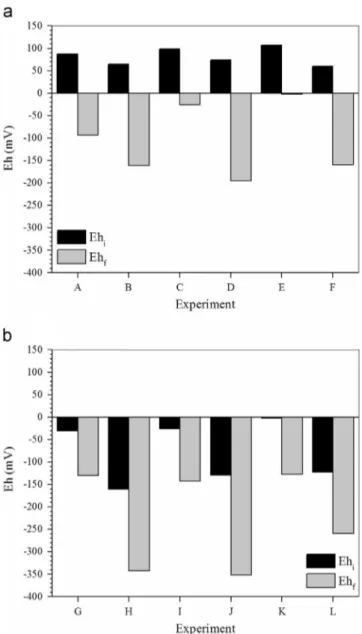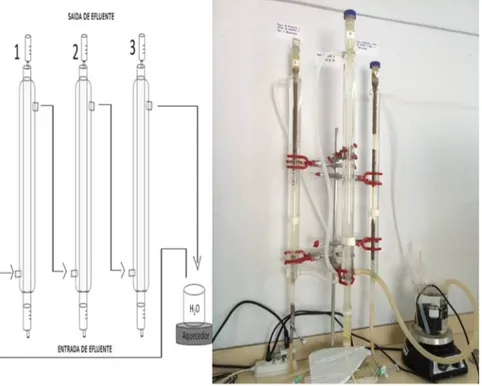Data Article
Data set on the bioprecipitation of sulfate and
trivalent arsenic by acidophilic non-traditional
sulfur reducing bacteria
Letícia Paiva de Matos, Patrícia Freitas Costa, Mariana Moreira,
Paula Cristine Silva Gomes, Silvana de Queiroz Silva,
Leandro Vinícius Alves Gurgel, Mônica Cristina Teixeira
⁎ Federal University of Ouro Preto, Campus Universitário Morro do Cruzeiro, s/n°, Bauxita, 35400-000 Ouro Preto, Minas Gerais, Brazila r t i c l e
i n f o
Article history:
Received 8 November 2017 Received in revised form 18 December 2017 Accepted 28 December 2017 Available online 2 January 2018
Keywords: Arsenite Sulfate reduction Bioremediation Immobilized cells Acid pH
a b s t r a c t
Data presented here are related to the original paper“ Simulta-neous removal of sulfate and arsenic using immobilized non-tra-ditional sulfate reducing bacteria (SRB) mixed culture and alter-native low-cost carbon sources”published by same authors (Matos et al., 2018) [1]. The data set here presented aims to facilitate this paper comprehension by giving readers some additional infor-mation. Data set includes a brief description of experimental conditions and the results obtained during both batch and semi-continuous reactors experiments. Data confirmed arsenic and sulfate were simultaneously removed under acidic pH by using a biological treatment based on the activity of a non-traditional sulfur reducing bacteria consortium. This microbial consortium was able to utilize glycerol, powdered chicken feathers as carbon donors, and proved to be resistant to arsenite up to 8.0 mg L−1.
Data related to sulfate and arsenic removal efficiencies, residual arsenite and sulfate contents, pH and Eh measurements obtained under different experimental conditions were depicted in graphi-cal format.
Refers tohttps://doi.org/10.1016/j.cej.2017.11.035
&2018 The Authors. Published by Elsevier Inc. This is an open access article under the CC BY license (http://creativecommons.org/licenses/by/4.0/).
Contents lists available atScienceDirect
journal homepage:www.elsevier.com/locate/dib
Data in Brief
https://doi.org/10.1016/j.dib.2017.12.064
2352-3409/&2018 The Authors. Published by Elsevier Inc. This is an open access article under the CC BY license (http://creativecommons.org/licenses/by/4.0/).
DOI of original article:https://doi.org/10.1016/j.cej.2017.11.035 ⁎Corresponding author. Fax:
þ55 31 3559 1069.
Specifications Table
Subject area Chemistry, Biology, Engineering
More specific
sub-ject area
Biotechnology processes, Bioremediation.
Type of data Table, image, graph,figure
How data was acquired
pH and Eh measurements: digital potentiostat with a combined platinum elec-trode (Digimed, DM-22).
Residual sulfate concentration: turbidimetric method[2].
Total arsenic content: determined by inductively coupled plasma optical emis-sion spectroscopy (ICP-OES) (Varian, 725-ES).
Data format Analyzed. Averaged data
Experimental factors
Brief description of any pretreatment of samples
Experimental features
Culture media was prepared as previously described[1,3]andincubated in an
oven (Fanem, model A-LT). Samples were centrifuged (10,000 rpm, 15 min,
Fiberlite F155-8×50cy, Thermo, Multifuge X1R) andfiltered (0.45
μ
m acetatecellulose membrane - Sartorius-Stedium) and acidified with nitric acid (50
μ
L)before residual As(III) measurements. Data source
location
Ouro Preto, Brazil
Data accessibility All data are included in this document.
Related research article
L. P. Matos, P. F. Costa, M. Moreira, P. C. S. Gomes, S. Q. Silva, L. V. A. Gurgel, M. C. Teixeira, Simultaneous removal of sulfate and arsenic using immobilized non-traditional SRB mixed culture and alternative low-cost carbon sources,
Chemical Engineering Journal, 334 (2018), 1630–1641.
Value of the Data
Different experimental conditions were compared. Free and immobilized bacterial cells were used.Different organic electron donors were tested including some low cost waste material.
Data compare results obtained under batch and semi-continuous experimental conditions. Semi-continuous experiments were carried out for a long time. Data were collected for more than150 days.
Arsenite (bio)precipitation by sulfate reducing microorganisms was achieved under acidic pH.1. Data
Data described simultaneous SO42−and As(III) removal obtained by using a non-traditional SRB
microbial consortium previously adapted to the growth under acidic pH using Glycerol and PCF as
electron donors. The main bacterial species identified are: Pantoea agglomerans,Enterobacter sp.,
Citrobactersp.,Cupriavidus metallidurans,Ralstoniasp. andBurkholderia cepacia. Arsenic and sulfate
are commonly found as contaminants in industrial effluents from mining and metallurgical
industries.
Arsenic and sulfate removal were obtained under batch and semi-continuous culture conditions.
Semi-continuous up-flow reactors were constructed and operated for more than 150 days to prove
their efficiency. At thefinal, effluent pH was neutralized and, depending on the operational
1.1. Batch experiments
Data presented inFigs. 1–4are referred to experimental conditions summarized inTable 1.
1.2. Semi-continuous experiments
Figures 5and6depict some results obtained during semi-continuous experiments. Experiments
were carried out in bioreactors operated according conditions described insection 2.2.4.
2. Experimental design, materials, and methods
Experimental design is detailed in Matos et al.[1]. All experiments and analyses were replicated
twice and data were averaged.
2.1. Materials
Analytical grade reagents – Calcium alginate, HNO3, HCl, NaOH, KH2PO4, NH4Cl, Na2SO4,
MgSO4·7H2O, HCl, FeSO4, sodium thioglycolate, ascorbic acid, ethylenediaminetetraacetic acid (EDTA),
glycerol, sodium lactate - were purchased from different suppliers. A Brazilian poultry plant provided the powdered chicken feathers (PCF) used as solid support material and chemical substrate for
microbial growth. Distilled or tap (when mentioned) waters were used for preparing solutions and culture medium.
2.2. Methods
2.2.1. Microbial consortium
A microbial culture was obtained after enrichment of some sediment samples, collected from an
urban pond, using modified Postgate C liquid medium[1,2]. Microbial culture was adapted to acidic
pH (5–5.5) and to the use of Glycerol as electron donor. Main identified microbial species were
Pantoea agglomerans,Enterobacter sp, Citrobacter sp;Cupriavidus metallidurans,Ralstonia spand
Bur-kholderia cepacia[1]. Microbial mixed culture was considered as a non-traditional sulfate reducing
bacteria (SRB) consortium.
2.2.2. Culture parameters
Microbial growth and process efficiency were indirectly estimated by measuring arsenic and
sulfate contents and pH and Eh (mV) changes as well.
Both, batch and semi-continuous experiments were conducted using free and calcium alginate
encapsulated microbial cells [1]. Postgate C liquid medium, at pH 5.5 was enriched with sodium
lactate, glycerol and PCF as carbon sources. Culture medium pH was acidified to pH 5.5. Microbial
tolerance to arsenic (4.0 and 8.0 mg of As(III) L−1) was accessed.
2.2.3. Batch experiments
Chemical oxygen demand (COD)-to-sulfate ratio used were 2.5 or 3.0, using sodium lactate or glycerol as main soluble carbon sources, respectively. Cultures were incubated in sterilized glass
bottles (Postgate B medium, 473 mL, pH 5.0) containing a 5% (w v−1) inoculum, PCF (2%) and 4.0 or
8.0 mg L−1 of As(III). An abiotic control flask was also compared. Flasks were sealed to minimize
Table 1
Batch experiments–visual summary chart.
Experimental Condition
Medium Electron donor
PCF As(III) (mg L-1) Postgate B Sodium lactate Glycerol
A B
C 4.0
D 4.0
E 8.0
F 8.0
G H
I 4.0
J 4.0
K 8.0
L 8.0
Fig. 6.Changes in Eh during sulfate and arsenic removal in semi-continuous reactors. PCFI 1: sulfate, immobilized PCF and tap water, PCFI 2: sulfate, immobilized PCF and distilled water and CONV: modified Postgate B liquid medium and distilled water. Initial As(III) concentration of 8.0 mg L−1, pH 5.0 and 34°C.
Oxygen dissolution and incubated at 35°C for 360 h. 2 mL aliquots were withdrawn for residual
sulfate concentration, pH and Eh measurements. Initial and final As(III) concentration were
determined.
2.2.4. Semi-continuous experiments
Four glass bioreactors (Fig. 7) were constructed as described by Matos et al.[1]. Bioreactors were
supplied with Postgate C medium and inoculated with microbial consortium adapted to different electron donors and pH values. Sodium lactate and PCF (PCFF, CONV), glycerol and immobilized PCF (PCFI 1, PCFI 2, CONV) and free PCF (PCFF) were tested as carbon sources. Free (PCFF, CONV) or encapsulated (PCFI 1, PCFI 2) microbial cells were inoculated into the systems. Additionally, the
suitability of using tap water (PCFI 1) instead of purified water (PCFF, PCFI 2, CONV) was tested.
Operating temperature was 3472°C and bioreactors were supplied by an up-flowflux. Monitored
parameters were pH, oxidation/reduction potential (Eh), residual sulfate and As(III) concentration. Bioreactors were operated during more than 150 days.
Acknowledgments
This study was supported by Federal University of Ouro Preto - UFOP and National Council for the Improvement of Higher Education CAPES (undergraduate and graduate scholarships) and Brazilian
National Research Council – CNPq (CNPq grant number 308861/2013-2) and Minas Gerais State
Research Funding Agency -FAPEMIG (FAPEMIG grant numbers CRA APQ-01807-09 and APQ-02366-14) funding agencies.
Transparency document. Supporting information
Supplementary data associated with this article can be found in the online version athttp://dx.doi.
org/10.1016/j.dib.2017.12.064.
References
[1]L.P. Matos, P.F. Costa, M. Moreira, P.C.S. Gomes, S.Q. Silva, L.V.A. Gurgel, M.C. Teixeira, Simultaneous removal of sulfate and arsenic using immobilized non-traditional SRB mixed culture and alternative low costs carbon sources, Chem. Eng. J. 334 (2018) 1630–1641.
[2]A. Kolmert, P. Wikström, K.B. Hallberg, A fast and simple turbidimetric method for the determination of sulfate in sulfate-reducing bacterial cultures, J. Microbiol. Methods 41 (2000) 179–184.
